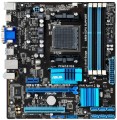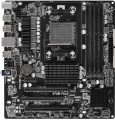Size (HxW)
Motherboard dimensions in height and width. It is assumed that the traditional placement of motherboards is vertical, so in this case one of the dimensions is called not the length, but the height.
Motherboard sizes are largely determined by their form factors (see above), however, the size of a particular motherboard may differ slightly from the standard adopted for this form factor. In addition, it is usually easier to clarify the dimensions according to the characteristics of a particular motherboard than to look for or remember general information on the form factor. Therefore, size data can be given even for models that fully comply with the standard.
The third dimension — thickness — is considered less important for a number of reasons, so it is often omitted.
Chipset
The chipset model installed in the motherboard. AMD's current chipset models are
B450,
A520,
B550,
X570,
A620,
B650,
B650E,
X670,
X670E,
B840,
B850,
X870,
X870E. For Intel, in turn, the list of chipsets looks like this:
X299,
H410,
B460,
H470,
Z490,
H510,
B560,
H570,
Z590,
H610,
B660,
H670,
Z690,
B760,
Z790,
H810,
B860,
Z890.
A chipset is a set of chips on the motherboard through which the individual components of the system inter
...act directly: the processor, RAM, drives, audio and video adapters, network controllers, etc. Technically, such a set consists of two parts — the north and south bridges. The key element is the northbridge, it connects the processor, memory, graphics card and the southbridge (together with the devices it controls). Therefore, it is often the name of the north bridge that is indicated as the chipset model, and the south bridge model is specified separately (see below); it is this scheme that is used in traditional layout motherboards, where bridges are made in the form of separate microcircuits. There are also solutions where both bridges are combined in one chip; for them, the name of the entire chipset can be indicated.
Anyway, knowing the chipset model, you can find various additional data on it — from general reviews to special instructions. An ordinary user, usually, does not need such information, but it can be useful for various professional tasks.Southbridge
Model of the south bridge installed in the motherboard.
This component of the "motherboard" is one of the constituent parts of the chipset. See above for details on the chipset; here we note that the south bridge is responsible for the interaction of the motherboard with peripheral devices: expansion cards (sound, network), drives, external USB peripherals, etc. Knowing the name of this module, if necessary, you can easily find detailed information about its characteristics and capabilities. An ordinary user, usually, does not need such information, but it can be useful for various professional tasks.
UEFI BIOS
The presence of
UEFI BIOS firmware on the motherboard.
Such firmware is usually combined with one of the classic "bios" (see BIOS). In fact, it is an additional add-on that expands the BIOS and makes it more convenient to manage. In some ways, UEFI approaches a full-fledged operating system: it has a convenient and understandable graphical interface even for a non-specialist, supports mouse control, is equipped with an extensive set of tools, and in some versions there is even the ability to access the Internet. In addition, this firmware takes into account all the features of modern computer hardware — including those that have appeared recently and are not covered in earlier, traditional BIOSes.
Max. clock frequency
The maximum RAM clock speed supported by the motherboard. The actual clock frequency of the installed RAM modules should not exceed this indicator — otherwise, malfunctions are possible, and the capabilities of the “RAM” cannot be used to the fullest.
For modern PCs, a RAM frequency of
1500 – 2000 MHz or
less is considered very low,
2000 – 2500 MHz is modest,
2500 – 3000 MHz is average,
3000 – 3500 MHz is above average, and the most advanced boards can support frequencies of
3500 – 4000 MHz and even
more than 4000 MHz.
Max. memory
The maximum amount of RAM that can be installed on the motherboard.
When choosing according to this parameter, it is important to take into account the planned use of the PC and the real needs of the user. So, volumes
up to 32 GB inclusive are quite enough to solve any basic problems and run games comfortably, but without a significant reserve for an upgrade.
64 GB is the optimal option for many professional use cases, and for the most resource-intensive tasks like 3D rendering,
96 GB or even
128 GB of memory will not be a limit. The most “capacious” motherboards are compatible with volumes of
192 GB or
more - they are mainly top-end solutions for servers and HEDT (see “In the direction”).
You can choose this parameter with a reserve – taking into account a potential RAM upgrade, because installing additional RAM sticks is the simplest way to increase system performance. Taking this factor into account, many relatively simple motherboards support very significant amounts of RAM.
AMP
The ability of the motherboard to work with RAM modules that support AMP technology (AMD Memory Profiles). This technology was developed by AMD; it is used in motherboards and RAM blocks and only works if both of these system components are AMP compatible. A similar technology from Intel is called XMP.
The main function of AMP is to facilitate system overclocking (“overclocking”): special overclocking profiles are “sewn” into memory with this technology, and if desired, the user can only select one of these profiles without resorting to complex configuration procedures. This is not only easier, but also safer: every profile added to the bar is tested for stability.
XMP
The ability of the motherboard to work with RAM modules that support
XMP (Extreme Memory Profiles) technology. This technology was developed by Intel; it is used in motherboards and RAM blocks and only works if both of these system components are XMP compliant. A similar technology from AMD is called AMP.
The main function of XMP is to facilitate system overclocking (“overclocking”): special overclocking profiles are “sewn” into the memory with this technology, and if desired, the user can only select one of these profiles without resorting to complex configuration procedures. This is not only easier, but also safer: every profile added to the bar is tested for stability.
SATA 3 (6Gbps)
Number of
SATA 3 ports on the motherboard.
SATA is now the standard interface for connecting internal drives (mainly HDDs) and optical drives. One device is connected to one such connector, so the number of SATA ports corresponds to the number of internal drives / drives that can be connected to the motherboard through such an interface. A large number (
6 SATA ports and more) is necessary in case of active use of several hard drives and other peripherals. For domestic use, 4 is enough. SATA 3, as the name suggests, is the third version of this interface, operating at a total speed of about 6 Gbps; the useful speed, taking into account the redundancy of the transmitted data, is about 4.8 Mbps (600 MB / s) — that is, twice as much as in SATA 2.
Note that different SATA standards are quite compatible with each other in both directions: older drives can be connected to newer ports, and vice versa. The only thing is that the data transfer rate will be limited by the capabilities of the slower version, and in some cases it may be necessary to reconfigure the drives with hardware (switches, jumpers) or software. It is also worth saying that SATA 3 is the newest and most advanced variation of SATA today, but the capabilities of this standard are not enough to unlock the full potential of high-speed SSDs. Therefore, SATA 3 is mainly used for hard drives and low-cost SSDs, faster drives are conn
...ected to specially designed connectors like M.2 or U.2 (see below).
